Menu
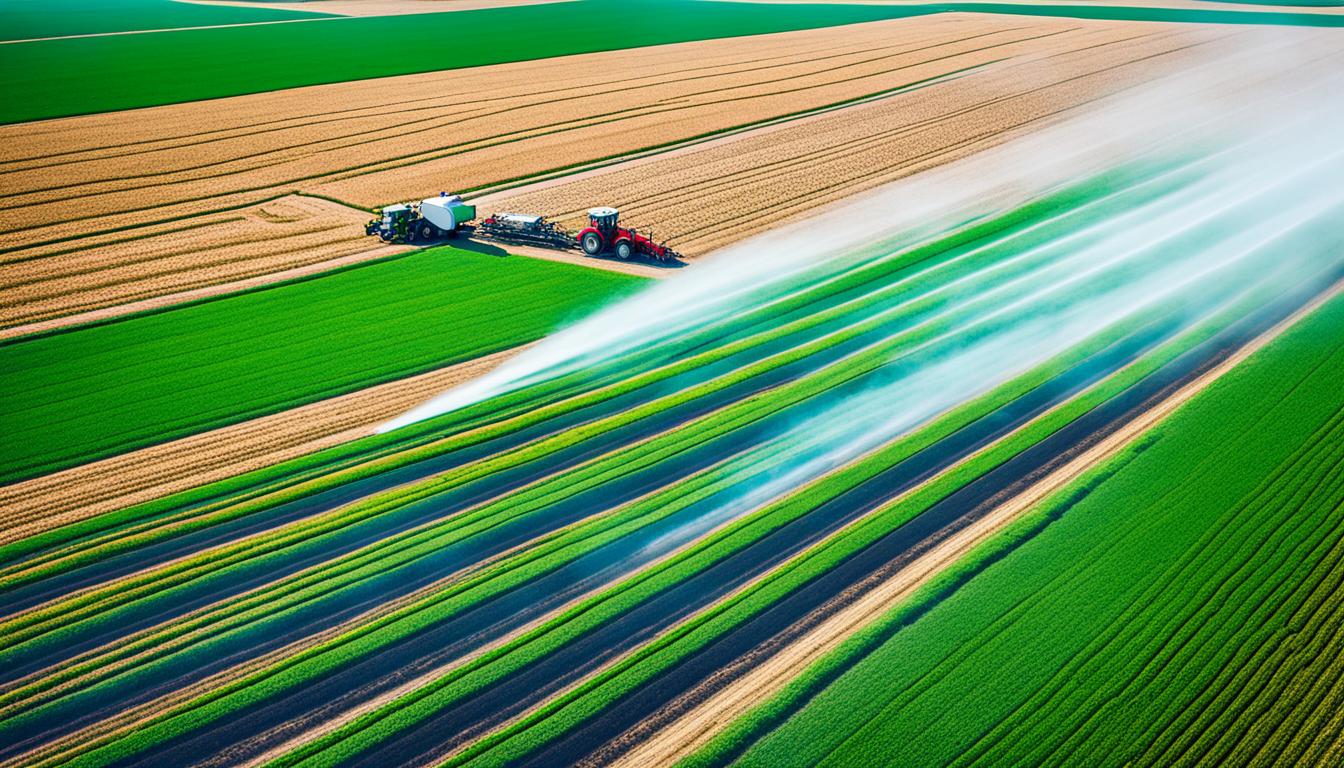
By 2050, the world’s population will hit 9.7 billion. With more people to feed, agricultural production needs to increase by 70%. This is why agricultural automation and modern farming practices are so important. Many farmers face labour shortages, leading them to choose crops that need less work.
Automation helps solve this issue by making farming more efficient. Companies like Agrobot and Bear Flag Robotics lead the way in automated farming. For example, one strawberry picking robot can pick a 25-acre field in three days. This saves the work of 30 people, who can then focus on other jobs.
Using robots in farming not only helps with work problems but also makes farms more sustainable. These systems can cut down on pesticide use by 90%. This means they’re great for modern farming practices and the overall health of the farm. Moving ahead, using automation in farming will be key to feeding the world and protecting the environment.
The story of farming is all about changes and new ideas. Early on, people learned to grow crops and raise animals. Over time, we’ve seen big leaps in technology that have changed how we work the land.
In the past, getting a fire going and cooking food marked big steps forward. These led to the start of using machines to farm, one of the biggest changes in agriculture.
Agricultural automation means using machines to do things on the farm better. It started with simple tools and has advanced to smart robots that can think for themselves. Automation makes farming faster, easier, and more accurate.
Today, the world needs more food than ever before. To meet this demand, the farming industry is turning to smart machines. These include self-driving tractors and pickers. Companies like Rabbit Tractor and Abundant Robotics are leading the way. They make machines that not only boost productivity but also help make farming more sustainable.
Automation in farming has many levels, from machines that help a bit to those that can do almost everything alone. These smart technologies rely on sensors and machines to better use resources on the farm. Now, we even have robots with advanced brains that can take on complex tasks.
A lot of different technologies help at different times. Machines help with the hard work, while smart technology helps make the best choices. This mix makes farming more efficient and productive.
| Technology Phase | Focus Areas | Impact on Farms |
|---|---|---|
| Manual Tools | Basic Tasks | Limited Efficiency |
| Animal Traction | Increased Power | Enhanced Productivity |
| Motorised Mechanisation | Performing Phase | Substantial Output Increase |
| Digital Equipment | Diagnosis and Decision-Making | Optimised Resource Management |
| Robotics with AI | Multiple Functions | Comprehensive Automation |
Smart farming is changing agriculture for the better. It’s bringing the newest technology to the field, making farms smarter and more efficient. This push is a big part of why we can produce more food than before.
With the global population set to hit 9.7 billion by 2050, we must boost agricultural production. This requires a 70% increase to serve future nutritional needs. Smart farming integrates advanced technologies to improve farming practices and production.
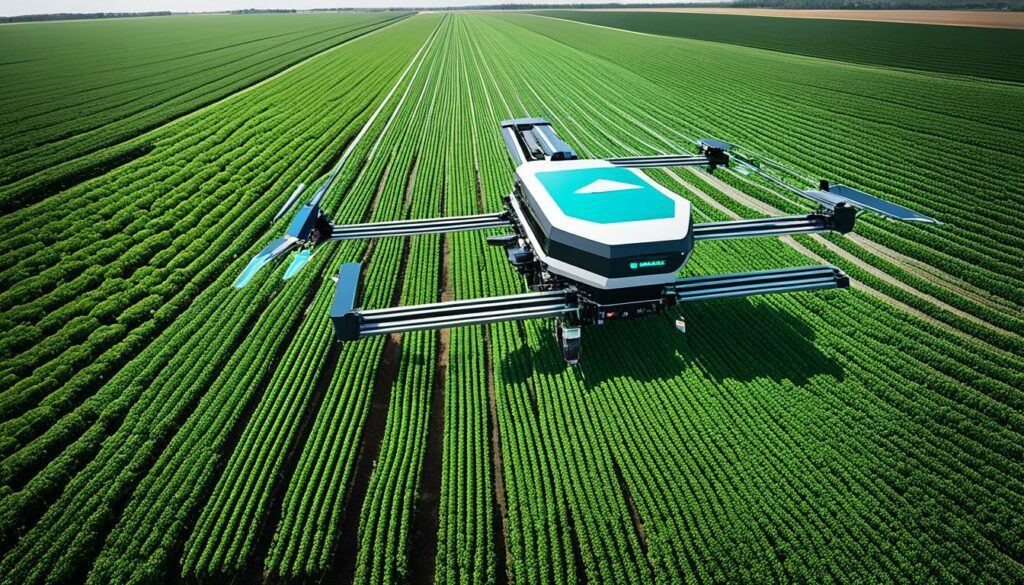
Smart farming, or automated farming, uses tech devices to make farming more efficient. It tackles key issues like lack of workers and the need for more crops. Companies are developing machines and systems to modernise farming.
Smart farming has several important technologies. Harvest automation uses machines to pick crops, reducing the need for lots of workers. This saves time and money.
Autonomous tractors do farm work on their own, saving time and effort. Seeding and weeding technologies plant seeds and remove weeds accurately, using less pesticide. Drones are now vital tools, providing crop and soil data from above quickly.
All these tools improve farm work and cut down on labour costs. But, their high prices are a big obstacle, especially for farmers in poorer countries.
| Component | Technology | Benefits |
|---|---|---|
| Harvest Automation | Robotic Harvesters | Reduced labour, increased picking speed |
| Autonomous Tractors | Self-driving Tractors | Precision, time-saving, labour reduction |
| Seeding and Weeding | Automated Seeders, Robotic Weeders | Optimal growth, reduced pesticide use |
| Agricultural Drones | Aerial Monitoring Systems | Enhanced decision-making, real-time data |
Companies like Blue River Technology and American Robotics are leading in smart farming. They show how these technologies are vital for the future of farming. As we continue, the mix of tech with farming will change the industry. It will lead to more crops and a greener future for all.
Precision agriculture is changing farming with smart equipment. It makes farming more efficient by using technology to apply resources like water, fertilisers, and pesticides exactly where they’re needed. This boosts crop production, leading to higher yields and better sustainability.
Currently, only 27 percent of U.S. farms use precision agriculture. This shows there’s a big chance for more farms to start using these helpful technologies. The USDA and the National Science Foundation recently gave nearly $200 million for precision agriculture research. This support shows how important these tools are for farms.
“Precision agriculture leverages automation technology and equipment to optimize farming tasks, increasing crop yields and profitability while reducing resource use like water, fertilisers, and insecticides.”
Precision agriculture equipment offers many benefits. It can lead to higher profits, less use of resources, and help the environment. But, there are also hurdles, like high costs and issues with sharing data and standards. Solving these problems needs policies that support innovation, finance, and data use.
Companies like John Deere stand out by creating high-tech tools for farming. Their gear allows careful monitoring and efficient use of resources. Products like the John Deere Operations Center™ make management easier with data tracking and sharing. Using such systems cuts costs and improves yields by using machines and resources better.
Automation in farming, like robots and smart vehicles, makes manual work easier. These tools help with tasks and let farmers look into other important matters. Devices that watch the environment, such as sensors, allow farmers to use data for decisions. Thanks to these systems, adjustments can be made from afar, saving time and making work more efficient.
Overall, precision agriculture changes farming for the better. With these technologies, farmers can enhance their crop production while making agriculture more sustainable and profitable.
Advanced technological devices in agriculture are changing farming for the better. They help farms be more efficient and meet increasing demands. These tools come in different types, each aiming to boost farming in special ways.
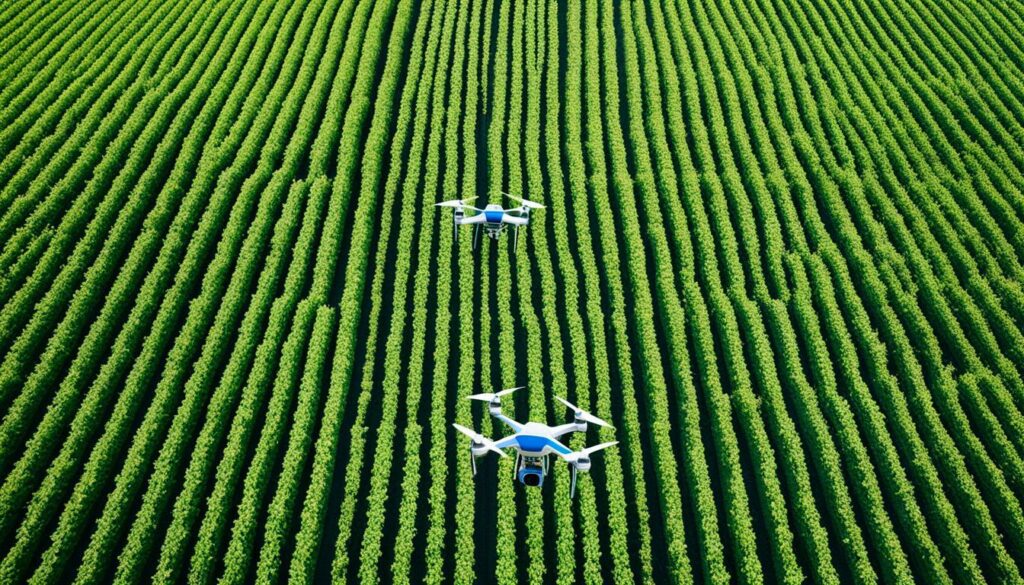
Various farming needs have their own automated tools:
Many companies are putting automated farming solutions to work:
Using these solutions can improve how resources are used, lower costs, and make farming better all round. The industry saw a $1.5 billion investment in 2017, showing it’s growing fast. There are now over 160 companies working in this area. So, the future of automated farming looks bright.
| Category | Key Benefits | Leading Companies |
|---|---|---|
| Automated Planting Systems | Precision seed placement, increased crop yields | John Deere, Blue River Technology |
| Precision Irrigation | Optimised water use, reduced waste | ecoRobotix, Valley Irrigation |
| Robotics for Harvesting | Reduced labour costs, efficient crop collection | Abundant Robotics, Agrobot |
| Data-Driven Yield Management | Enhanced crop production, improved resource management | Bear Flag Robotics, American Robotics |
Using technological devices in agriculture helps us farm in a way that’s good for our planet. I think incorporating these new tools will lead to big improvements in farming efficiency.
Robotic farming tools are bringing about big changes in how we grow crops. They are making old ways of farming high-tech, more efficient, and accurate. These tools can plant, remove weeds, and pick crops with amazing precision. This change not only boosts how much we can grow but also cuts down on the work needed and is kinder to the environment.
Take Blue River Technology, for example. It uses computers and robots to apply weed killer very precisely. This is good for the earth. Robots are also doing things like cutting grass, watching over plant health, and arranging fruits and veggies. Places like the University of Cambridge are working on new projects. They’re using flying robots with the latest sensors to help out on farms.
There are lots of good things about using robots on farms. They make jobs quicker, are kinder to the planet, and bring lots of new ideas. Harvest Automation, Tortuga AgTech, and Harvest CROO are leading the way. They’re creating clever systems for picking crops better. And there are companies like Carbon Robotics and Naïo Technologies. They are making tools that can weed and cut grass very accurately.
Switching to farming with robots is a big move for supporting the planet. The farming robot market is set to grow from a $13.5 billion business in 2023 to over $40 billion by 2028. This is really changing the game in North America. There, businesses are quickly adding automation to fields and factories.
Here’s a quick look at how robotic farming tools are changing things:
| Aspect | Impact of Robotic Farming Tools |
|---|---|
| Labour Efficiency | Enhanced efficiency, reducing dependency on manual labour |
| Environmental Impact | Reduced chemical usage and minimized environmental footprint |
| Market Growth | Expansion from $13.5 billion in 2023 to over $40 billion by 2028 |
| Technical Innovations | Advanced technologies for crop monitoring and management |
Robotic farming is turning the tide towards smart, eco-friendly growing. As we push on, the dream of entirely automated, green farming gets closer.
In today’s farming world, using the right machinery is key in cutting down on labour costs. This is especially true as we look to the future. By the year 2050, our planet will hold 9.7 billion people. To feed everyone, we must boost agricultural output by 70%. That’s where efficient farm tools come in.
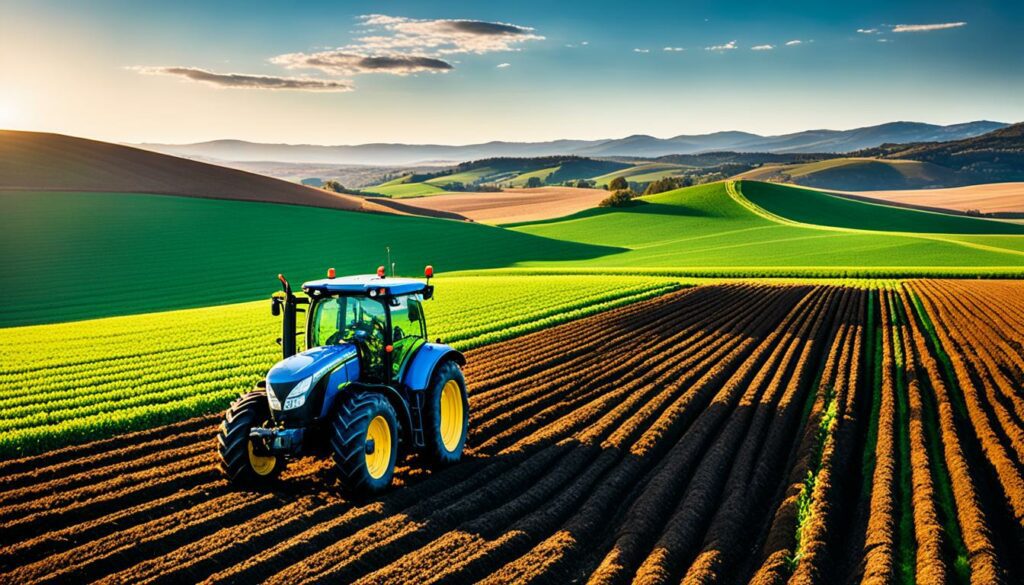
Good machinery means more work gets done in less time. This cuts how much we need to depend on people working with their hands. Not only that, but it also helps grow more food while using less money. Machines that can work round the clock, without tiring, play a big part in this.
Yet, it’s not just about working faster. These machines are smarter too. They can farm in clever ways, like treating each plant differently based on its needs. This could mean using sprays only where they’re needed. This high-tech approach might cut down on the harmful chemicals we put in the environment by as much as 90%.
Real-life stories show just how much better life on the farm has become with the right machines. Take, for example, a robot designed to pick strawberries. In just three days, it could do the work of 30 people on a 25-acre field. This is not just about making farming easier. It’s a clear sign of how using machines can save us a lot of money. Also, these gadgets can farm with the environment in mind. They might mean we use far fewer chemicals, which is great for our planet.
| Impact Area | Traditional Methods | Efficient Farm Machinery |
|---|---|---|
| Labour Efficiency | 30 workers for 25 acres | 1 robot for 25 acres |
| Pesticide Usage | High with traditional spraying | 90% reduction through precision techniques |
| Production Costs | Higher due to labour and time | Lower due to automation and consistency |
By 2050, the world will likely have 9.7 billion people. To feed everyone, we’ll need 70% more food. Crop automation is key. It uses AI and ML to better manage how we grow crops.
These systems check on crops, guess how much food they’ll make, and make farming tasks smoother. For example, machines that pull up weeds can see what’s a weed and what’s not. This means they don’t need as much harmful spray. It’s better for the planet. Machines also help with not enough farmers to work, which is a big problem for farms.
With crop automation, we can use just the right amount of water and nutrients. This makes farming more environmentally friendly. Less water and chemicals are wasted.
Take, for instance, robots that pick strawberries. One robot can pick a huge field in only three days. It does the work of 30 people. This not only makes farming more productive but also cleaner.
“Kubota’s precision farming system further illustrates the strides being made in smart agriculture solutions. By visualising farm operations with data-based farming techniques, it optimises fertiliser application and water management, crucial for improving crop quality and yield management.”
Crop automation brings many benefits. It helps us grow more food, use resources smarter, and be kinder to nature. This kind of farming is getting more common. It’s happening fast because we need to feed more people.
The future of farming is getting more automated, with advanced robots leading the way. Companies like Tortuga AgTech, Harvest CROO, and FFRobotics are pioneering this trend. Tortuga’s fruit-picking robots are incredibly precise, needing only one supervisor. Harvest CROO has a robot that picks strawberries very fast. And FFRobotics’ fruit harvester works ten times quicker than a human.
Advanced robots are also changing how we do things in other areas. For example, the LaserWeeder by Carbon Robotics uses lasers to kill weeds without hurting crops. Scythe Robotics’ M.52 mower has lots of sensors and smart AI for cutting grass precisely around things. This shows how robotics can make farming a lot more accurate.
Naio Technologies and Nexus Robotics are also part of this future. Naio’s Ted helps out in vineyards, doing jobs like weeding. Nexus has the R2Weed2, which can tell the difference between plants and weeds with AI. These technologies are making farming more efficient and kind to the environment.
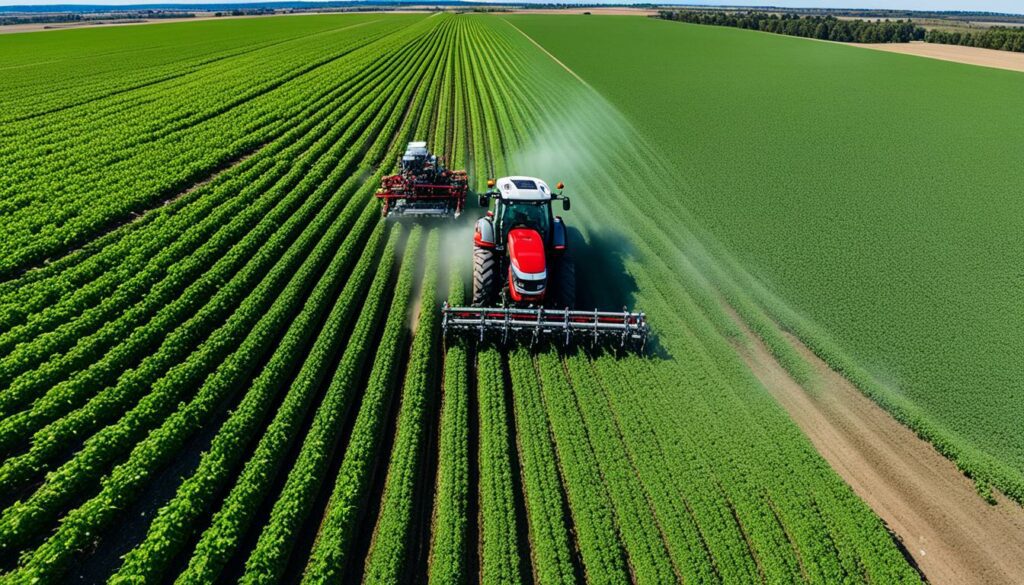
This new tech is great for the planet, cutting down on water and improving farming. Bowery Farming can use 90-95% less water thanks to vertical growing. AppHarvest’s use of AI and robots helps save water and produce more food. They aim to get their produce to most people in the US within a day. This saves water and meets the food needs of more people as the population grows.
Using these cutting-edge farming tools doesn’t just help the planet; it makes good business sense. The market for these technologies is growing and expected to be worth billions by 2028. Automation tools like Monarch Tractor and Global Unmanned Spraying System are proving to be very valuable. They can save farmers a lot of money each year. Not many farmers are using this tech yet, but that’s likely to change as it becomes more affordable. This change will make farms more productive and green.
| Company | Robot | Function | Key Feature |
|---|---|---|---|
| Tortuga AgTech | – | Fruit Picking | 98% Accuracy |
| Harvest CROO | – | Strawberry Harvesting | Picks a Plant in 8 Seconds |
| FFRobotics | – | Fruit Harvesting | 10 Times Faster than Humans |
| Carbon Robotics | LaserWeeder | Weed Control | Uses Laser Technology |
| Scythe Robotics | M.52 Mower | Mowing | Advanced AI & 360-Degree Perception |
| Naio Technologies | Ted | Weeding | Operates in Vineyards |
| Nexus Robotics | R2Weed2 | Weed Differentiation | AI-Powered |
Putting automated tools to work in farming is key. It keeps productivity high when we’re facing more people to feed and less workers. This journey towards using technology in farming starts by figuring out what each farm needs. That means looking at what crops are grown, how much land there is, and what machines or tools are already in use.
First off, farm needs must be clearly seen. This looks at the crops, what resources are on hand, and how automation could help. Then, it’s time to pick the right tech. There are choices like driverless tractors, robots for picking crops, more precise watering systems, and even drones.
Making the new tech work with what’s already on the farm is a big deal. This might mean updating old machines or adding new parts so they can keep up. Special kits can be used to make old equipment ready for new tech.
Getting into automation isn’t easy. One of the first big hurdles is how much this advanced gear costs. It can be a lot and might be too much for small farms or those in developing areas. But there are ways to get help, like loans or grants, to make it easier.
There are also tech challenges and the risk of machines breaking. Good training and support from the companies that make the equipment are very helpful. And making sure things are looked after and spare parts are available can reduce the effect of machines quitting.
Overall, starting to use tech in farming has some tough bits. But by taking it step by step, with clear goals and ways to deal with problems, it can bring big advantages. This can mean getting more work done, spending less on workers, and being better for the planet, all making farming’s future brighter.
In recent years, harvest automation has stepped into the spotlight. It’s changing how we harvest crops. By using new technology, it aims to make farming more efficient, cut down on labour costs, and improve the quality of what we collect.
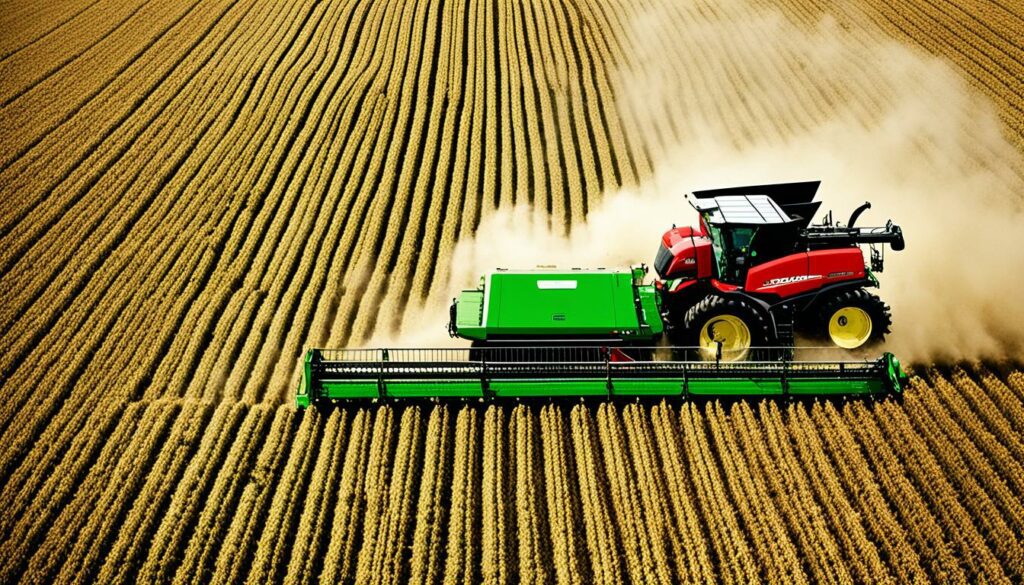
Robots are now picking crops, which is a big step for the industry. Take Agrobot, for example. They’ve created robots that can pick strawberries gently. These robots pick each fruit carefully, keeping its quality high, and they work faster than people do.
Crop harvesting innovation is also seen in Abundant Robotics’ work. They’ve made robots that pick apples. These machines work faster and more consistently than humans, allowing us to collect more apples in less time. This reduces how much we need human workers and makes sure fresh apples reach the market on time.
The money side of harvest automation is growing fast. Investors have put over $10 billion into robotic farming and its growth. Technologies like AFS Harvest Command help too. They adjust farm machines automatically to waste less produce and work more efficiently.
These new ways of harvesting are having a bigger impact too. They’re not only upping how much we collect but also aiming for eco-friendliness. For example, Rabbit Tractors are using self-driving tractors to work the fields better. This helps farms run smoother and is better for the environment, especially important with climate change challenges.
Autonomous tractors are changing how we farm today, bringing big steps in efficiency and safety. Since 2013, TYM has led the way in making self-driving tractors. They made models for simple and complex tasks. In 2021, TYM even launched a model that’s super precise, the best in Korea.
These tractors work with fancy tech like remote control, really good GPS, and sensors for watching things in real-time. Monarch Tractor made the first all-electric, no-driver-needed tractor in 2022. Their special AI helps the tractor see in all directions, monitor what’s happening, and stop it from crashing into stuff. This tech makes farming today a lot better and safer.
Bear Flag Robotics is also a big part of making tractors smart. They found ways to turn regular tractors into self-driving ones. These changes save money, solve the lack of farm workers, and let one person manage many tractors at once.
There’s a big push to use these smart tractors because there aren’t enough farm workers and we need to farm better. They can work all the time, which is great for planting and harvest times. Since most farmers are over 60, the need for machines that can work without people is even more important.
These tractors are great at using things like water, seeds, and fertilisers just right. This makes farming less wasteful and better for the planet. Also, the data they collect helps farmers learn how to make their crops healthier and how to farm smarter.
Autonomous tractors are really safe too. They have sensors to avoid hitting things and can stop on their own in an emergency. This new farming tech doesn’t just make farms more productive. It also keeps everyone working on the farm safe and protects the land.
| Feature | Benefit |
|---|---|
| 24/7 Operation | Continuous productivity, especially during peak seasons |
| Precision GPS | Minimized overlaps and optimized resource application |
| 360° Vision | Enhanced safety and real-time monitoring |
| Labour Scarcity Management | Allows one operator to oversee multiple tractors |
With autonomous tractors, farming is becoming more efficient, cheaper, and kinder to the planet. These new farming and tractor technologies are vital for the farming challenges we face today and in the future.
In 2050, the world’s population is set to reach 9.7 billion. This will need a 70% increase in food. Because of this, it’s key to be precise in how we plant and remove weeds.
Technology like robotic seeding helps a lot. It’s great because it solves the problem of not having enough people to work on farms. This lack of workers makes some farmers grow crops that don’t need as much work. But, using machines for planting can change this.
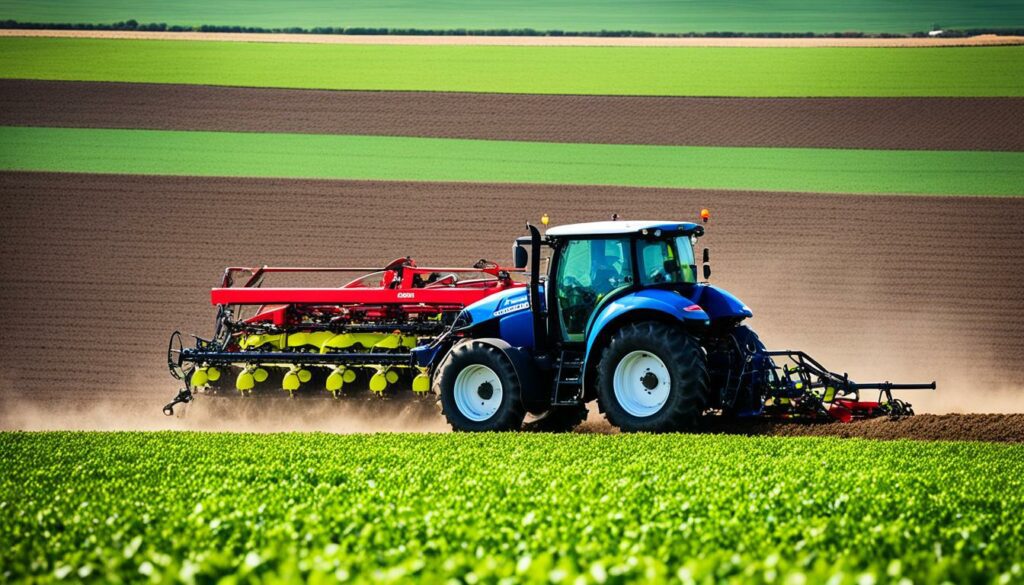
Companies like Blue River Technology make tools that can really change farming. Their machines can see and know just where to use pesticides. They use up to 90% less of these harmful chemicals.
This is good news for the planet. It means we have more food that is safe to eat and that we’re not hurting the earth with too many chemicals.
Buying these farm machines might be expensive at first. This can be hard for small farmers. But, there are now cheaper options available too. This makes the special planting machines more affordable for all farmers.
For example, Rooted Robotics makes a simple machine for planting seeds in small plants like microgreens. They also plan to make machines for planting bigger crops correctly. Terra Robotics has robots that can remove weeds without hurting the environment.
The market for farm robots will get very big, from $13.4 billion in 2023 to $86.5 billion in 2033. The need for farming machines is growing because people don’t want to use too many chemicals on their food.
Using these new tools for planting and weeding brings a lot of good things. It increases how much food we get, cuts down on costs, and helps the planet. So, it’s clear that using careful methods in farming is very important for the future.
| Statistic | Implication |
|---|---|
| Global population projected to reach 9.7 billion by 2050 | Need for 70% increase in agricultural production |
| Labor shortages impact 55% of farmers | Shift towards less laborious crops by 31% of farmers |
| Automated farming can reduce pesticide usage by 90% | Reduces environmental footprint significantly |
| Global agricultural robotics market growth | Projected to reach $86.5 billion by 2033 |
Agriculture is changing fast thanks to drones. They bring accuracy, speed, and improved data. Estimates say the drone market will grow to $4.8 billion by 2024. This shows drones are becoming vital in farming.
Drones come in different types for various farm tasks. Multi-rotor drones are great for photos, crop checks, and spraying on small to medium farms. Fixed-wing drones cover large areas fast and are good for big farms or fields.
The advantages of using drones in farming are huge. They can boost crop yields by 5%. South Korea leads in using drones for 30% of their spray work. This technological shift means fewer people are needed to spray fields by hand.
Drones collect better data quickly, even on cloudy days. This helps monitor crop health and spot pests. They also help by using less chemicals, making farming more eco-friendly. Australian research is improving drone tech for irrigation.
Innovative planting drones are also impressive. They can plant up to 400,000 trees a day with just two people. Even with some challenges, the benefits of drones, like those from American Robotics, are clear.
| Benefit | Description |
|---|---|
| Increased Yields | Precision farming systems using drones can boost yields by up to 5%. |
| Efficient Data Collection | High-resolution imagery collected faster than traditional methods. |
| Labour Reduction | Drones save workers from manual field navigation, improving efficiency. |
| Environmental Sustainability | Optimised input application reduces chemical use and environmental impact. |
Automated farming offers many benefits to both producers and consumers. It provides fresher and more sustainable agricultural products.
Advanced technology allows producers to closely watch and manage the farming process. This leads to better quality produce.
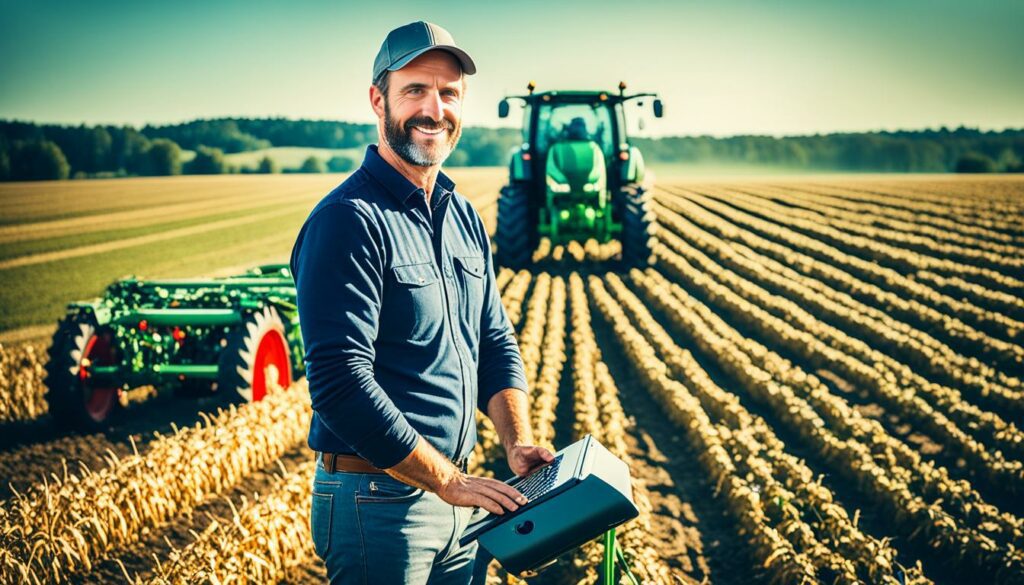
Sustainable agricultural products are a major plus. Automated systems use fewer chemicals, helping to protect the soil and rivers from pollution.
This is great news for consumers who prefer organic and eco-friendly foods. Plus, automation shortens the time it takes for food to reach the table. So, people get fresher food that tastes better and is more nutritious.
Automation is also key in making food safer. About 60 percent of new diseases come from animals. Automated systems’ precision and control help stop these diseases from spreading to us. This boosts food safety for everyone.
It’s worth noting the economic benefits too. Automation cuts costs by improving how products are made and lowering the need for workers. These savings can then lower food prices for consumers.
Also, it means producers can keep up with the demand for top-quality food. Consumer needs are more easily met, thanks to automation.
So, automated farming is a big win for consumers. It brings us sustainable products, safer food, and lower prices. This makes for a healthier and greener food system for us all.
By 2050, the world’s population should hit 9.7 billion. This means we need to produce more food. Our goal is to increase farm output by 70% to meet everyone’s needs. Farm automation plays a key role in making farming more productive and planet-friendly. This article looks at how advanced farming tech, like robots and drones, is changing agriculture for the better.
Farm automation is great at applying pesticides and fertilisers exactly where they are needed. Robots and smart cameras can cut down pesticide use by 90%. This means fewer chemicals end up in our soil and water. It also means less waste and healthier soil. By being smart about where inputs go, farm tech can help the planet a lot. It cuts down on farming’s greenhouse gas emissions too.
Many studies show that farm automation is good for the environment. For instance, strawberry-picking robots can work as well as 30 people in just three days on a 25-acre farm. This saves a lot of money, which is great since labour costs make up over half of a farm’s expenses. Such tech also helps when there’s not enough workers to do the job. Companies like Rabbit Tractors and ecoRobotix are leading the way in using smart machines to use water and energy better. They are also reducing how much we harm the planet.
Using farm automation has its challenges, like the cost and keeping the special equipment working. But, it’s very important for the future of farming that’s good for the Earth. Robots, drones, and smart farming tools are needed to save resources and cut down on pollution. As we work towards using less CO2 by 55% in 2030 and reaching zero pollution by 2050, these technologies are vital. They are key to making sure our food comes from a sustainable and healthy planet.
Agricultural automation is using machines and technology to do farm work. It makes farming more efficient and productive.
The journey of agricultural automation has seen non-stop improvements. It began with basic tools for farming and now we have smart farming technologies, thanks to leaders like Agrobot and Bear Flag Robotics.
Smart Farming uses technology to make farming better. It improves how farms work by using smart tech for daily tasks.
The main parts are Harvest Automation, Autonomous Tractors, and Seeding and Weeding tech. It also includes Agricultural Drones. These technologies boost efficiency and cut down on costs.
It helps farmers get the most crops with less waste. By using the right amounts of water and fertilisers, plants grow better. This way, farms are managed smarter and resources are used well.
There are automated planting systems and precise irrigation. Also, there are robots for harvesting and high-tech management of crop yields. All these help make farming more efficient and productive.
We see robotic harvesting by Abundant Robotics and energy-saving machines by ecoRobotix in action. They help farming meet productivity goals while being eco-friendly.
Robotic tools are changing how we grow crops by making seeding, weeding, and harvesting very accurate and efficient. This saves on costs and helps the environment. Innovators like Blue River Technology are leading this change.
Good farm machines boost how much is produced, need fewer people to work, and speed up farming from start to finish. This is good for the Earth and saves money too.
For example, a robot picking strawberries worked like 30 people but in just three days over 25 acres. This shows how it’s good for money and the planet.
These are modern systems using tech to get the best crop results. They do things like check plant health, guess how much we’ll get from a field, and water and feed the crops automatically.
The future is more AI making sure crops and animals are looked after well and farms are run smoothly. This is more about getting the best with less harm to nature.
First, farming needs are figured out. Then, the right tech is picked and put into the farm. This is helped by training and tech support.
Setting up can cost a lot and be complex. But, companies are giving good training, support, and fixes for old machines to help out.
New machines can pick fruits gently, making work easier and faster. For example, Agrobot’s robots and Abundant Robotics’ apple pickers are changing the game.
These tractors use remote controls, but they can also work alone with special commands. They fit onto old tractors too, which makes farming safer and more effective.
These tractors mean farming is done better and is cheaper and safer. Companies like Bear Flag Robotics are leading this change.
It’s using smart robots and AI to treat crops just right. This means we use less pesticides and still get a good harvest. Blue River Technology is one doing this well.
There are drones with lots of rotors and with fixed wings. They watch over crops, spread fertilisers, and help make smart decisions with fresh data.
Drones tell us what crops need fast, can go over tough areas, and make quick fixes. Companies like American Robotics make drones that do all this by themselves.
Farm machines give us fresh, good food that’s made the right way at better prices. They also make sure there’s enough food we can feel good about eating. This is good for everyone.
Farming smarter helps save on bad chemicals and not waste water and power. Companies like Rabbit Tractors and ecoRobotix show us how this saves the planet.
Yes, studies on smart farming show less water and energy used, and fewer bad chemicals. This is good for nature and making farms money too.